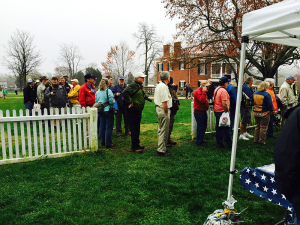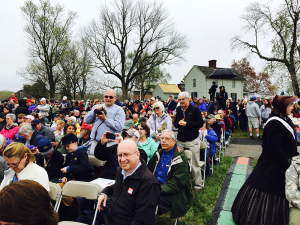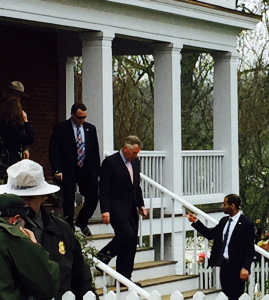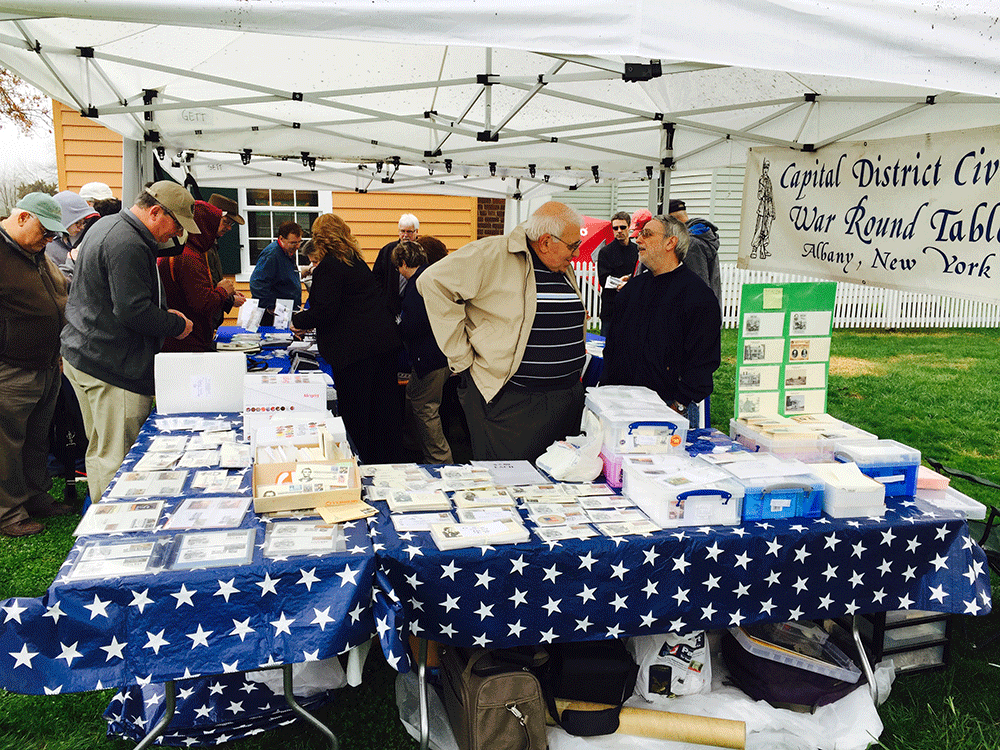[The article on the stamps themselves is here.]
[Photos courtesy VSC member Rollin Berger]
 Long lines and a post office that hadn’t read the first-day instructions from USPS Cancellation Services in Kansas City. The clerks brought the only the cancels intended for Five Forks to the first day ceremony at the Appomattox Court House National Park, but didn’t bring enough stamps. For that, they might be forgiven, because the National Park Service rangers estimated 10-15,000 people at A.C.H. on the 150th anniversary of the surrender that all but ended the Civil War, versus the approximately 50 visitors it gets on a normal day.
Long lines and a post office that hadn’t read the first-day instructions from USPS Cancellation Services in Kansas City. The clerks brought the only the cancels intended for Five Forks to the first day ceremony at the Appomattox Court House National Park, but didn’t bring enough stamps. For that, they might be forgiven, because the National Park Service rangers estimated 10-15,000 people at A.C.H. on the 150th anniversary of the surrender that all but ended the Civil War, versus the approximately 50 visitors it gets on a normal day.
There was also frustration at the Appomattox post office, where clerks refused to allow use of the red registry dater every post office must have – even after several calls from USPS Stamp Fulfillment Services. Resolution had to await the return of the postmaster from A.C.H. around 4 p.m. before the dater could be used.
However, VSC member Foster Miller  (shown here) says this was an excellent, if long, first day ceremony.
(shown here) says this was an excellent, if long, first day ceremony.
The advance USPS press release said reenactors portraying Generals Robert E. Lee and Ulysses Grant would bring to life the surrender, and thattwo descendants of soldiers portrayed in the painting on which the Appomattox stamp is based would attend: Dennis Bigelow, descendant  of Lt. Col. Chas. Marshall, Lee’s aide at the Appomattox surrender (pictured to Lee’s immediate right in stamp image); and Al Parker, descendant to Grant’s Military Secretary Lt. Col. Ely S. Parker (pictured to Grant’s immediate left). Parker, by the way, was a Native American.
of Lt. Col. Chas. Marshall, Lee’s aide at the Appomattox surrender (pictured to Lee’s immediate right in stamp image); and Al Parker, descendant to Grant’s Military Secretary Lt. Col. Ely S. Parker (pictured to Grant’s immediate left). Parker, by the way, was a Native American.
Virginia Governor Terry McAuliffe was among the dignitaries at the ceremony.
First day covers were being sold at the ceremony by the Capital District Civil War Round Table, including unserviced ArtCraft cacheted envelopes for $5 each. 




Pingback: Civil War 1865: Five Forks, Appomattox (U.S. 2015) | virtualstampclub.com
Virginia Governor Terry McAuliffe (and Senator Tim Kaine) left before the USPS stamp ceremony began.
Lloyd said that the USPS only brought the Five Forks cancels. Actually, they only brought the Five Forks cancel (singular) – just one device (despite the fact that SFS sent them multiple devices).
The USPS initially brought 15,000 sheets of the Civil War: 1865 stamp; they had to go back and get more. The stamp sales line averaged about 200 people in length; in part because the USPS only two people selling the stamps. For the size of the crowd, they should have at least ten sales stations.
Grant’s Military Secretary Lt. Col. Ely S. Parker, a Native American from the Seneca tribe wrote out the surrender agreement because he had the best penmanship of anyone in the parlor at the McLean House. He didn’t have a pen, so he borrowed one from Lt. Col. Chas. Marshall, Lee’s aide and the only person who accompanied Lee to the McLean House. As Lloyd points out, descendants of both Parker and Marshall were at the ceremony.
Lee was reported to initially be taken aback by Parker’s dark skin. When Lee found out that Parker was a Native American, Lee remarked “At last, a real American”. Parker responded “No, General, today we are all again Americans”.
The first day ceremony took place outside McLean House, the site of the 1865 surrender of Lee to Grant. The back story on Wilmer McLean is interesting. Anyone who has visited the Manassas Battlefield has seen the home of sugar grocer Wilmer McLean, as much of First Battle of Manassas took place on his Yorkshire Plantation where his house served as the headquarters of Confederate Gen. Beauregard. In 1863, McLean moved his family and slaves 120 miles southwest to get away from Union troops and to be nearer to his business. He moved to Appomattox County to the small town of Appomattox Court House. On April 9, 1865, aides to Lee and Grant agreed to use the parlor of Wilmer McLean’s house to meet to finalize the surrender agreement.
The first major battle of the Civil War took place on the plantation of Wilmer McLean in Manassas and the surrender agreement was signed in the parlor of his new house in Appomattox Court House.